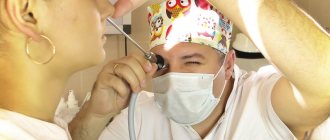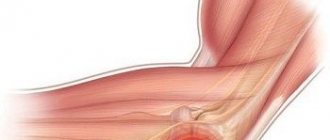Condition Characteristics
The pathology is characterized by nonspecific pain radiating to the lumbar region, perineum, vagina, rectum or external genitalia. Chronic pelvic pain syndrome usually has a vague onset. This diagnosis is indicated if pain has been present for more than six months. An important feature of the condition is the absence of pathologies in tissues and organs that can cause discomfort.
The disease is unpleasant because it significantly reduces the quality of life, and therefore requires qualified and adequate help.
Treatment of piriformis syndrome
FMS is a pathology of the musculo-ligamentous system with severe pain in the buttock area, as well as its irradiation to nearby areas.
The piriformis muscle (from Latin - musculus periformis) is located under the layer of the gluteus maximus muscle and passes through the sciatic foramen. At one end it is attached to the sacrum, and at the other to the greater trochanter of the femur. Its function is to externally rotate the hip (rotation) during extension and abduct the hip during flexion. Reflex tension and the neurodystrophic process in it often occurs when the L5-S1 roots are irritated.
If the cause of the disease is not detected at the initial stage, the symptom complex of the piriformis muscle can progress quite quickly, leading to sciatica.
Symptoms
The clinical picture consists of three signs:
- local;
- indicating damage to the adjacent nerve of the sacral plexus;
- compression of the vessels of the sciatic nerve, as well as the inferior gluteal artery.
It is for this reason that three types of manifestations of the disease can be observed. Local symptoms include aching pain in the buttock area, radiating along the back of the thigh and lower leg, as well as pain in the hip and sacroiliac joints. When changing position, the pain does not disappear. It gets worse when sitting still for a long time. You can get relief only while lying down or sitting with your legs apart.
The second group of symptoms includes “dull” pain with a burning sensation or chilliness radiating throughout the entire limb. With significant compression of the nerve by the pathologically altered piriformis muscle and sacrospinous ligament, weakness of the leg flexors, foot paresis, decreased sensitivity in the lower part of the leg and the outer edge of the foot, decreased or loss of the Achilles reflex, and autonomic disorders in the lower leg and foot are possible. And if the vessels of the sciatic nerve and inferior gluteal artery are affected, difficulties arise when walking - the person takes a forced body position and must periodically stop or sit down.
Etiology
Typically, the causes of pathology are primary and secondary. Primary – if the disease is caused by damage to the muscle tissue itself. Among them:
- spraining or excessive strain during training;
- hypothermia;
- injuries to the gluteal or lumbar regions;
- myositis of the piriformis muscle;
- incorrectly performed injection;
- long-term stay in an antalgic, that is, forced position.
Secondary causes of SHM are pathologies of the pelvic organs and problems in the connective structure of the ilium and sacrum.
There are another number of factors in the occurrence of the disease. These are vertebrogenic and non-vertebrogenic causes, that is, related to the spine area.
Vertebrogenic:
- spinal cord or spine injuries;
- lumbar radiculopathy;
- narrowing of the intervertebral foramina;
- spinal tumors.
Non-vertebral pain includes: referred pain in diseases of other internal organs, as well as myofascial pain syndrome.
Diagnostics
In the examination, it is important that the nerve is compressed below the origin of the nerve branches to the gluteus medius and minimus and the tensor fascia lata muscle of the proximal femur, so EMG reveals their intactness. Transrectal palpation should be performed and the patient checked for the following symptoms:
- Freiberg - when the bent hip rotates inward, the affected piriformis muscle gives painful sensations;
- Pace's symptom - in a supine position on the healthy side, the side of the sore side is raised; when lifting the leg bent at the knee, pain appears;
- Bonnet-Bobrovnikova - with complete relaxation of the muscles, performing a passive internal rotation of the hip;
- Beatty's symptom - when lying on the healthy side, when raising the straight leg upward, pain appears in the buttock;
- Mirkina - detection of pain when bending forward with straight legs.
In addition, the amplitude of movements is studied.
Novocaine blockade of the S1 root and piriformis muscle is of no small importance in making a diagnosis. The subsequent weakening or reduction of pain along the sciatic nerve indicates that the unpleasant sensations are not caused by neuritis, but by its compression.
For a complete examination, as well as for differential diagnosis:
- electroneurography – to analyze the condition of the muscles of the lower limb and the conductivity of the sciatic nerve;
- computed tomography - to obtain a three-dimensional image of the insides;
- radiography of the hip joints;
- Ultrasound of the pelvic organs.
The specificity of the muscle being studied is such that manual diagnostic methods are important in its examination.
In addition to all of the above, differential diagnosis is carried out with pathologies that have similar symptoms. For example, it is necessary to exclude the presence of an intervertebral hernia. The difference is that with a hernia, pain begins at the damaged nerve itself. With the disease described, the entire nerve suffers. Differential examination is required if lumbosacral plexitis and vascular diseases are suspected.
In some cases, it may be necessary to consult a vertebrologist, oncologist, urologist, or gynecologist.
Treatment
An indicative factor of this disease is that severe pain is not eliminated by NSAIDs and painkillers.
Therefore, the main treatment is infiltration blockade of the musculus periformis, and we also perform injections into the trigger points of the peroneal and gastrocnemius muscles. For physiotherapy, we recommend ultrasound or phonophoresis with hydrocortisone, shock wave therapy. Manual therapy, reflexology, massage are prescribed to relieve muscle spasms and reduce pain.
Pathogenesis
Experts agree that treatment of chronic pelvic pain must be carried out with a focus on the possible causes of its occurrence. As a rule, this is a whole complex of factors that affect a woman’s condition. Ineffective treatment of the underlying disease significantly increases the risk of CPPS. Since all organs in the pelvis are interconnected, the pathological process can cause unpredictable disorders.
There are several dozen causes of pain.
- Gynecological.
endometriosis;
- inflammatory processes of organs in the pelvis;
- sexually transmitted infections;
- adhesions;
- ovulatory and menstrual pain;
- endometrial polyps;
- tumor growths in the genital organs;
- traumatic injuries.
- chronic urinary tract infection;
- chronic colitis;
- dysfunction of the pelvic floor muscles;
Also, chronic pain can be psychogenic in nature: the result of depression, stress disorders, post-traumatic conditions, and schizophrenia.
Causes of chronic pelvic pain
Organic causes of the disease:
- inflammatory diseases of the reproductive system, for example: salpingitis, oophoritis, endometritis, cervicitis;
- benign and malignant tumors, cysts;
- endometriosis ー appearance of endometrial tissue (inner lining of the uterus) in atypical places, i.e. on other organs;
- adhesive process in the pelvic cavity;
- varicose veins of the pelvis;
- urological diseases: urolithiasis, cystitis, pyelonephritis;
- intestinal pathology;
- lumbosacral osteochondrosis.
A disease without an organic cause is detected in less than 2% of cases. This is typical for people with an unstable emotional state, hypochondria, a tendency to nervous breakdowns, neurasthenia, and depression.
Symptoms
First of all, treatment of chronic pelvic pain syndrome in women is aimed at improving quality of life and reducing symptoms. That is why the doctor carefully collects anamnesis to find out the reason that worries the patient.
Most often, women complain of the following symptoms:
- nagging pain in the lower abdomen;
- lower back pain;
- painful syndrome during menstruation;
- dyspareunia (pain during sexual intercourse, before or after sexual intercourse);
- vulvodynia (stabbing pain in the vestibule of the vagina or perineum).
The syndrome can manifest itself constantly or be cyclical. With a long course of the disease, the psycho-emotional state changes: CPPS provokes irritability, insomnia, reduces activity, is one of the factors of depressive and hypochondriacal moods, and leads to social maladjustment.
Classification of chronic pelvic pain syndrome
There are three stages of development of CPPS:
- Organ stage
. The pain is local, limited to one area, and does not spread to nearby organs. According to the patient's subjective assessment, it corresponds to the severity of the disease. There are no psychoemotional disorders. - Supraorgan stage
. The pain spreads to other areas along the nerves. - Polysystem stage
. In addition to the high intensity of the pain syndrome, there are disorders of the functioning of the pelvic organs. The consequences are: disruptions of the menstrual cycle, metabolic disorders due to hormonal dysfunction. At this stage, serious psycho-emotional disorders develop.
Establishing diagnosis
Treatment for chronic pelvic pain in Moscow is offered by the Dr.AkNer clinic. You can undergo comprehensive diagnostics to determine the causes of the pathology and develop effective treatment.
The list of examinations for CPPS includes the following measures:
- gynecological examination;
- rectal examination;
- tests for sexually transmitted diseases;
- local ultrasound;
- assessment of blood flow in the area of discomfort;
- x-ray of the sacral and lumbar spine;
- histological studies;
- diagnostic laparoscopy.
Diagnosis of chronic pelvic pain syndrome
Patients with CPPS should be carefully examined for organic pathology, inflammatory processes and neoplasms. To do this, the doctor will prescribe the following tests and examinations:
- gynecological examination;
- Ultrasound of the pelvic organs;
- hysterosalpingoscopy;
- tests for genitourinary infections;
- X-ray methods: urography, cystography;
- endoscopic examinations: hysteroscopy, colonoscopy, cystoscopy;
- diagnostic laparoscopy;
- MRI, CT.
In the absence of a pathology that can cause intense pain, the patient needs consultation with several doctors: a gynecologist, urologist, neurologist, gastroenterologist, orthopedist, oncologist, psychologist, psychiatrist.
Therapy
Treatment of chronic pelvic pain in women involves a multi-vector approach. When pathologies are identified, complex therapy is prescribed, antibiotics or antiviral drugs are prescribed, and inflammatory foci are stopped.
The main direction in the treatment of CPPS is the use of symptomatic therapy: patients are prescribed non-narcotic analgesics, as well as non-steroidal anti-inflammatory drugs to improve the quality of life.
Physiotherapeutic methods of influence have proven themselves well. Taking into account the situation, the patient may be advised to visit a psychotherapist, rehabilitation specialist, or neurologist.
At the Dr.AkNer clinic you can count on a sensitive attitude and a comprehensive, highly professional approach to your problem. Our specialists will make every effort to make you forget about the painful illness and enjoy life again.









